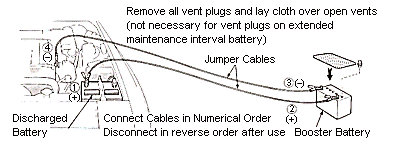If Your Vehicle Will Not Start
(a) Simple Checks.
Before making these checks, make sure you have followed the correct starting procedure given in How To Start The Engine and that you have suffcient fuel.
If the engine is not turning over or is turning over too slowly ...
- Check that the battery terminals are tight and clean.
- If the battery terminals are O.K., switch on the interior light.
- If the light is out, dim or goes out when the start is cranked, the battery is discharged. You may try jump starting. But your vehicle cannot be push started.
- If the light is O.K., but the engine still will not start, it needs adjustment or repair. Call a Toyota dealer or qualified repair shop.
Do not pull-start the vehicle. It may damage the vehicle or cause a collision when the engine starts. Do not try push-starting either. The catalytic converter may overheat and become a fire hazard.
If the engine turns over at its normal speed but it will not start ...
- 7M-GE engine only ... Check that all the push-on connectors are tight at the ignition coil, distributor, and spark plugs. (See Engine Compartment Overview for location of these parts)
- If the connectors are O.K. the engine may be flooded because of repeated cranking. See Starting the flooded engine for further instructions.
(b) Starting a Flooded Engine.
If the engine will not start, your engine may be flooded because of repeat cranking.
If this happens, turn the key to "START" with the accelerator pedal held down. Keep the key and accelerator pedal held for 15 seconds and then release them. Then try starting the engine with your foot off the accelerator pedal.
If the engine does not start after 15 seconds of cranking, release the key, wait a few minutes and try again.
If the engine still will not start, it needs adjustment or repair. Call a Toyota dealer or qualified repair shop for assistance.
NOTICE:
Do not crank for more than 15 seconds at a time. This may overheat the starter and wiring systems.
(c) Jump Starting.
 To avoid serious personal injury and damage to your vehicle which migh result from battery exposion, acid burns, electrical burns, or damaged electronic components, these instructions must be followed recisely.
To avoid serious personal injury and damage to your vehicle which migh result from battery exposion, acid burns, electrical burns, or damaged electronic components, these instructions must be followed recisely.
If you are unsure about how to follow this proceure, we strongly recommend that you seek the help of a competent mechanic or towing service.
| CAUTION:
|
NOTICE:
The battery used for boosting must be 12V. Do not jump start unless you are sure that the booster battery is correct.
JUMP STARTING PROCEDURE
- If the booster battery is installed in another vehicle, make sure the vehicles are not touching. Turn off all unnecessary lights and accessories.
- Remove all the vent plugs from the booter battery. Lay a cloth over the open vents on the booster battery. (This helps reduce the explosion hazard.)
If the booster battery is an extended maintenance interval battery, it is not necessary to remove the vent plugs. - If the engine in the vehicle with the booster battery is not running, start it and let it run for a few minutes. During jumping run the engine at about 2000 rpm with the accellerator pedal lightly depressed.
- Connect the jumper cables in the exact order shorn in the illustration: positive-to-positive ( + ), and negative to engine or body ground ( -- ). Note that you first connect the positive cable to the discharged batter. Next, connect the negative cable to the booster battery and then to a solid, stationary metallic point i(e.g. engine hanging hook) away from the battery. Do not connect it to or near any part that moves when the engine is cranked.
NOTICE:
When making the connections, do not lean over the battery or accidentally let the jumper cables or clamps touch anything excepr the correct battery terminals or the ground. - Start your engine in the normal way. After starting, run it at about 2000 rpm for several minutes with the accelerator pedal lightly depressed.
- Carefully disconnect the cables in the exact reverse order: the negative cable and then the positive cable.
- Carefully dispose of the battery cover cloths - they may now contain sulfuric acid.
- Replace all battery vent plugs